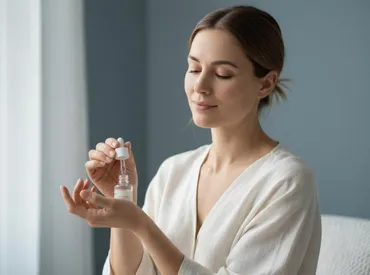
The Ultimate Guide to Carrier Oils for Essential Oils (2024)
Discover the best carrier oils for your essential oils. Learn how to choose, dilute, and safely use coconut, jojoba, argan, and other oils for any skin type.

Discover the best carrier oils for your essential oils. Learn how to choose, dilute, and safely use coconut, jojoba, argan, and other oils for any skin type.

FUPA is an acronym for 'Fat Upper Pubic Area.' Learn what it means, what causes it, and the different ways to address it, from exercise to body positivity.

Yes, oolong tea contains caffeine. Discover exactly how much, factors that influence its levels, and how it compares to coffee and other teas.

Is the viral ice water hack a secret to weight loss? We dive into the science of thermogenesis, deconstruct the recipes, and expose the supplement scams.

Explore the causes of rosy cheeks, from harmless flushing to signs of rosacea or other conditions. Learn about treatments and the cultural meaning.

Is it safe to use baby oil as a sexual lubricant? Medical experts say no. Learn about the risks, including condom failure and infections, and discover safer alternatives.

Discover the science behind sleeping naked and weight loss. Learn how it indirectly supports fat loss by improving sleep quality, balancing hormones, and boosting metabolism.

Is it safe to drink alcohol while on blood thinners like Warfarin, Eliquis, or Aspirin? Understand the serious risks, drug-specific interactions, and when to abstain.

Explore the dual identity of Carl Leto: a renowned ophthalmologist in Virginia and the adoptive father who gave Jared and Shannon Leto their famous surname.

Searching for Dr. Brena Taylor? We clarify the confusion between real doctors named Brenda Taylor, the tragic story of Breonna Taylor, and a surprising movie connection.

Discover the exact calories in a pear, plus a full nutritional breakdown by size, variety, and form (fresh, canned, dried). Learn about the health benefits.

Ever feel itchy or tingly after taking pre-workout? We break down the science behind beta-alanine, niacin, and how to manage or avoid the harmless 'pre-workout itch.'
In our fast-paced world, the terms "health" and "wellness" are used everywhere, but what do they truly mean? Too often, we think of health as simply not being sick. However, a deeper understanding reveals a much richer, more proactive concept that encompasses every aspect of our lives.
The World Health Organization (WHO) provides a foundational definition, stating that health is "a state of complete physical, mental, and social well-being and not merely the absence of disease or infirmity." Wellness, then, is the active, conscious pursuit of this holistic health. It's about the daily choices we make that lead to a fulfilling and balanced life. This guide will explore the core dimensions of wellness, provide actionable steps for improvement, and delve into the modern challenges and opportunities in achieving true well-being.
To truly thrive, we must nurture several interconnected areas of our lives. While some models include up to eight dimensions, most experts agree on five fundamental pillars of wellness.
!A graphic showing five interconnected circles labeled Physical, Mental, Emotional, Social, and Spiritual Wellness. Image Source: Unsplash
Physical wellness involves maintaining your body's health through proper care. It’s the most visible dimension and includes:
This dimension refers to your cognitive and emotional state. It's about your ability to process information, cope with stress, and maintain a positive outlook.
As social creatures, our connections with others are vital. Social wellness involves building and maintaining healthy, supportive relationships and feeling a sense of belonging within a community. Strong social ties can buffer against stress, enhance self-esteem, and provide a critical support network.
Spiritual wellness does not necessarily mean religion; it involves having personal beliefs and values that provide a sense of purpose and meaning in life. It's about finding peace, harmony, and a connection to something larger than yourself, which contributes to overall fulfillment.
A one-size-fits-all approach to health is becoming obsolete. The future of wellness is personal, driven by technology and a deeper understanding of our individual biology and lifestyle.
To personalize wellness, we first need to measure it. This involves a combination of:
The fusion of big data, artificial intelligence (AI), and wearable devices is empowering a new era of personalized healthcare. Health apps can analyze your data to provide tailored recommendations for diet, exercise routines, and even stress-reduction techniques, creating a dynamic and responsive wellness plan unique to you.
!A person checking their health and fitness data on their smartphone and smartwatch. Image Source: Unsplash
The global wellness industry is valued at over $5.6 trillion, and while it offers many valuable tools, it also presents challenges. It's crucial to distinguish between scientifically validated practices and commercially driven trends.
Evidence-based health relies on rigorous, peer-reviewed scientific research to guide decisions. Reputable organizations like the National Institutes of Health (NIH) provide science-based information on treatments and therapies. When considering a health strategy, it's vital to seek out practices backed by solid evidence.
The commercial wellness market has exploded, driven by a desire for proactive health management. While this has brought positive attention to prevention and lifestyle medicine, it has also led to the spread of misinformation. As a group of former U.S. Surgeons General warned, it's essential that health decisions are guided by science, not ideology or marketing.
True wellness is not achieved in a vacuum. The conditions in which we are born, live, work, and age—often called social determinants of health—play a massive role in our overall well-being.
Achieving health equity means creating environments where everyone has the opportunity to thrive, regardless of their background.
Improving your health and wellness is a personal journey, but you don't have to do it alone. Numerous resources are available to support you.
By embracing a holistic view, making informed choices, and advocating for healthier communities, we can all move beyond simply "not being sick" and toward a state of genuine, vibrant well-being.